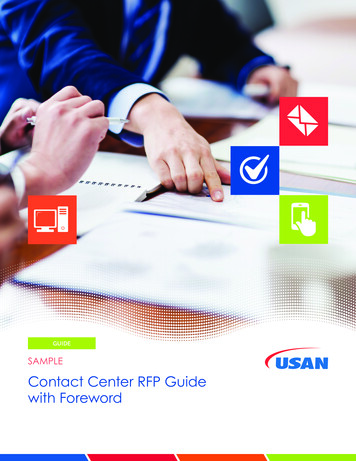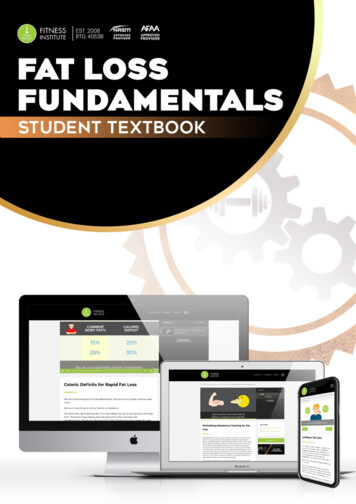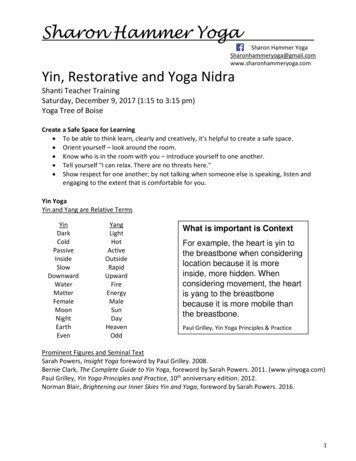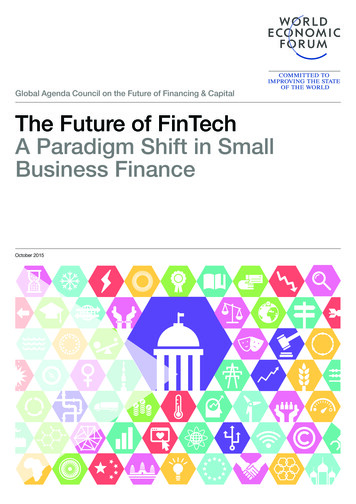
Transcription
Mental Health Stigma:The Elephant In The Room
Foreword From Our FounderIt’s time for us to admit that ‘employee wellbeing’ has simply become another buzzwordfor many organisations.In short, it’s become another way for businesses to say “look, we’re doing right by ouremployees and this is a great place to work”.We have to ask ourselves, “what’s meaningfully changed over the past few years?”.Since I lost my Dad to suicide in 2009, with very few warning signs, I still often questionhow many businesses are proactively supporting their employees to prevent them fromreaching crisis stage.The problem is, most businesses are approaching workplace wellbeing by: Running one-off mental health initiatives Relying on HR to solve wellbeing on their own Only providing reactive interventions like an EAP or MHFAs Guessing what employees need Not tackling workplace mental health stigmaSadly, HR and People Professionals feel the brunt force of this.Don’t get me wrong, seeing businesses do something for employee wellbeing insteadof ignoring it altogether is encouraging. But the statistics still show mental ill-healthremains the most common cause of long-term absence1 and accounted for 50% of allwork-related ill health cases in 2020/20212.In addition, our data (to be revealed) confirmed our concerns that organisations areseeing little improvement by forgetting to address the elephant in the room. mentalhealth stigma.We have to do better and that’s our aim with this report. To highlight some key statisticsbut also provide you with some practical solutions that can make a real difference.Paul McGregorFounder, Everymind at Work1 CIPD (2021). Health and Wellbeing at Work 2021.2 HSE (2021). Work-related stress, anxiety or depression statistics in Great Britain, 2021.2
Has Stigma Truly Been Tackled?At Everymind at Work, we are on a mission to help employees feel safe to talk about mental healthin the workplace. We know that at any given time, 1 in 6 working-age adults have symptomsassociated with mental ill-health3 and that mental ill-health remains the most common cause oflong-term absence4 and accounted for 50% of all work-related ill-health cases in 2020/20215.It is therefore encouraging to see that following the pandemic, 83% of HR leaders are planningto ramp up investment around employee wellbeing6 and mental health is now the most commonfocus of health and wellbeing activity for employers4.Despite these promising statistics, our data insights collected between 2021 and 2022 show thatorganisations are seeing little return when failing to tackle mental health stigma. We’ve pulled out6 of our key findings below.80%45%80% of employeeshave struggled withtheir mental health45% of employees wouldspeak to no one at workabout their mental health53%73%53% of employees would beworried about telling theiremployer if they had a mentalhealth condition, in case itwould negatively impact them**73% of HR professionalssay that it is hard toengage employees inwellbeing initiatives**68%68% of employees wouldbenefit from extra help tomanage their mental healthEmployees ranked ‘Lackof Confidence’ as thechallenge they need themost support with3 McManus S, Bebbington P, Jenkins R, Brugha T. (eds.) (2016). Mental health and wellbeing in England: Adult psychiatric morbidity survey 2014.4 CIPD (2021). Health and Wellbeing at Work 2021.5 HSE (2021). Work-related stress, anxiety or depression statistics in Great Britain, 2021.6 Benefex (2021). Employee Experience In The New World of Work.3
Defining Mental Health Stigma In 2022Stigma is defined as “a mark of disgrace associated with a particular circumstance, quality, orperson”. In relation to mental health, stigma involves the social disapproval, discrediting ordiscrimination of individuals with a mental health condition.Mental illness has long been stigmatised in societies worldwide and although attitudes havechanged since the Middle Ages when the mentally ill were imprisoned or even killed, the currentpopulation still largely fears individuals suffering from ill-mental health and ignorance is prevalent.For example, statistics show that over a third of the public think people with a mental health issueare likely to be violent7.The term ‘mental health’ itself has negative connotations. During our interactive webinar sessions,we often ask attendees what word(s) they associate with the word ‘mental’. Here is an example ofthe responses we get:7 Time to Change (2015). Attitudes to Mental Illness 2014 Research Report.4
As you can see, quite often the responses we get include words like ‘mad’, ‘crazy’ and ‘nuts’. This isdue to associative activation where our brains automatically associate the phrase ‘mental’, and thus‘mental health’, with many negative connotations without us even realising it. In contrast, whenmost people hear ‘physical health’ they would likely have positive connotations (e.g. strength orfitness); highlighting that mental health stigma is still a societal problem.The stigma associated with mental illness is often divided into three types: public, self andinstitutional stigma.Public StigmaPublic stigma refers to the negative attitudes that society has towardsindividuals with mental illness. This typically stems from stereotypes,prejudice and misconceptions. As a result, many people think thatindividuals with a mental illness are dangerous, incompetent or to blamefor their disorder for example.Self-StigmaSelf-stigma is when an individual internalises the misconceptions of thepublic and has negative attitudes towards their own mental illness. As aresult, they may feel that they are dangerous, incompetent, broken or toblame for their own condition, thus increasing shame and exacerbation ofsymptoms.Institutional StigmaInstitutional stigma is more systemic. In relation to the workplace, it is whenan organisation’s policies and procedures, intentionally or unintentionally,negatively affect those with mental health conditions, often invisibly. As aresult, this can become embedded in the organisation’s culture.90,000It is estimated that only 1 in 8adults with a mental health problemreceive any kind of treatment8A study of over 90,000 people worldwidefound that stigma of mental illness is one ofthe top reasons that they don’t receive care98 McManus S, Bebbington P, Jenkins R, Brugha T. (eds.) (2016). Mental health and wellbeing in England: Adult psychiatric morbidity survey 2014.9 Clement, S., Schauman, O., Graham, T., Maggioni, F., Evans-Lacko, S., Bezborodovs, N., Thornicroft, G. (2015). What is the impact of mental healthrelated stigma on help-seeking? A systematic review of quantitative and qualitative studies. Psychological Medicine, 45(1), 11-27.5
The Effects of Mental Health StigmaFor people with mental health conditions, the stigma they experience from the public, themselvesor institutions can exacerbate the struggles they are facing. In fact, nearly 9 out of 10 people with amental illness feel that stigma and discrimination negatively impact their lives10. Below are someof the harmful effects that mental health stigma can have on an individual:Reluctance to seek help and/or treatment, causing delayedor prolonged recoveryMore likely to experiencebullying, harassment anddiscriminationIncreased psychologicalsymptomsFeeling isolated and excluded,leading to further social withdrawalLack of support from friends,family and colleaguesFewer opportunities foremployment or social interactionsLow self-esteem andconfidenceHesitation to pursueopportunitiesWhen it comes to the workplace, our data has highlighted that lack of confidence is areal issue for employees currently. On average, employees agree that they criticisethemselves a lot and do not feel confident*; it was therefore no surprise when ‘Lack ofConfidence’ was ranked as the challenge they need the most support with when it comesto mental health and wellbeing.10 Mental Health Foundation (2021). Stigma and discrimination.6
Mental Health Stigma at WorkRecent research by McKinsey & Company11 found that 65% of people with a mental illness perceivestigma in the workplace and less than 1 in 10 employees describe their workplace as free of stigmaon mental illness. However, ‘reducing stigma’ ranks last when employers list their top mentalhealth priorities, despite 75% of the same employers acknowledging the presence of stigma intheir workplaces. Moreover, they found that 80% of employees believe an anti-stigma or awarenesscampaign would be useful, however, only 23% of employers reported having implemented such aprogramme.Unfortunately, this is not surprising as the abstract nature of stigma often deters employers fromtackling it; yet the cost of ignoring workplace mental health stigma can be detrimental to both theorganisation and its employees.Here are some questions you may want to consider when it comes to identifying stigma in yourorganisation Could you identify the ‘1 in 6 working adults’ that are struggling with their mental health? Are you unaware that employees are struggling until you see mental ill-health stated on adoctor’s note? Is engagement in wellbeing initiatives low? Do your people managers care about their employee’s mental health? Do employees cite mental health as a reason for absence? Do they have the means to do so? Do employees access/use your wellbeing benefits? Are burnout, presenteeism or leaveism high in your organisation? How are you measuring or assessing the level of stigma within your organisation? Do you have a health and wellbeing section within your engagement survey? If so, are youuncovering whether employees feel safe and cared for by their manager and the company?47%47% of respondents with amental illness believe that theircolleagues would think theyare worthless if they knewabout their mental illness1153%53% of respondents with amental illness believe thattheir colleagues would doubttheir character if they foundout about their mental illness1150%50% of respondents with amental illness believe that theircolleagues would think theyhave little talent or skill if theyknew about their mental illness1111 McKinsey & Company (2021). Overcoming stigma: Three strategies toward better mental health in the workplace.7
How to Move From a Culture of Stigmato SupportThe 3 Pillars to Improve Workplace Mental WellbeingTo transform employee wellbeing, we believe that organisations need to implement a wellbeingstrategy that is broken down into three key pillars: Promote, Provide and Protect. As there is no ‘onesize fits all’ approach, these three pillars must be informed by the unique needs of the organisationand its employees to have a meaningful and long-lasting impact on employee wellbeing.For years, businesses have focussed too heavily on the final pillar - Protect. These are reactivesolutions that help employees in the midst of a crisis. There is a place for these interventions in theworkplace, but they should not be the key focus. Implementing initiatives that do not tackle stigma,or require psychological safety, will not be engaged with if mental health stigma is rife. Instead,a wellbeing strategy should support a proactive approach to wellbeing, where the Promote andProvide pillars aim to negate the need for crisis support and make employees comfortable toengage and talk about mental health at work.So, how can you use the Promote and Provide pillars to reduce mental health stigma in theworkplace?8
10 Key Ways To Reduce Stigma In Your OrganisationMental health stigma needs to be addressed at an organisational, team and individual level. Herewe have summarised 10 key ways you can do this:1Educate all employees2Publicly commit to supporting employee wellbeing3Promote a healthy working environment by minimisingrisks to mental wellbeing4Ensure the correct language is used in all communications5Empower, educate and encourage people leaders6Foster psychological safety within teams7Focus on equality, diversity and inclusion (ED&I)8Offer appropriate workplace adjustments9Create conversations10Share stories9
1. Educate All EmployeesAt Everymind at Work, we strongly believe that everyone has a part to play in reducing workplacemental health stigma. Stigma typically derives from a lack of understanding and education ofmental illness and mental health in general. If you can educate ALL employees, it will not onlyreduce stigma but also help them to better support themselves and those around them.Through such education programmes, you should focus on reinforcing positive messages and givingemployees permission to learn and be curious. If a company adopts a coaching style culture whereit’s ok to ask questions, raise ideas and give feedback, where ‘failing fast’, learning and moving onis encouraged, employees start to feel safer in their environment. By promoting and celebratingwellbeing through education and other initiatives, it will become the norm and help reduce mentalhealth stigma within the organisation.One tip is to start utilising language like ‘wellbeing’, ‘wellness’ or more relatable terms such as‘stress’ to gain initial attention as opposed to ‘mental health’. We’ve also seen benefit from bringingin external speakers to be a catalyst for change and focusing on positive mental health before goingon to discuss ill-mental health. It’s about gradually chipping away at the stigma, one step at a time.P.S. the Everymind Champion course is a great place to start!At work, who would you most likely speak to about your mental health?HR - 3.17%Other - 2.17%MHFA - 2.11%Line manager - 17.89%No one at work - 45.22%Colleagues - 29.44%Our data insights show that 45% of employees would speak to no one at workabout their mental health. Of the 55% that would speak to someone at work,they would most likely speak to their colleagues (29.44%). This highlights theimportance of ALL employees having a solid understanding of how to supportothers because you never know when someone might reach out.10
2. Publicly Commit To Supporting Employee WellbeingIt is believed that 46% of organisations still lack a formal strategy and tend to act on an ad-hocbasis when it comes to employee health and wellbeing12. This approach can foster stigma, makingwellbeing initiatives look like a ‘tick-box exercise’. To show employees that you truly care abouttheir wellbeing, it needs to be engrained in everything you do and clearly align with companyvalues.The best way to start this is by publicly committing to support employee wellbeing. For example,you could try calling out wellbeing within your employee value proposition (EVP) to attract newrecruits, e.g. “one of our strengths is our commitment to employee wellbeing via our many initiativescarrying full leadership support”. You may want to make a formal statement on your public (e.g.website, social media) as well as internal communication channels. Or you can partner with awellbeing provider, like Everymind at Work, who will work with you to implement a successfulwellbeing strategy worth shouting about!46%of organisations still lack a formalstrategy and tend to act on an ad-hoc basis whenit comes to employee health and wellbeing12.3. Promote A Healthy Working Environment By Minimising Risks ToMental WellbeingStatistics show that 822,000 British workers suffered from work-related stress, depression oranxiety in 2020/2113, yet one in five HR professionals report their organisation is not taking anysteps to identify and reduce work-related stress12.The risks to employee mental health at work, typically fall into one of five categories: jobcharacteristics, role characteristics, the work environment, relationships and/or the individual.Employers may not be able to control all of these factors, but it is important that they are aware ofthem and implement any interventions that may help proactively support employee mental healthand wellbeing.It is therefore advised that organisations complete a business-wide mental wellbeing riskassessment at least once a year which, by default, will cover many psychological elementssupportive of reducing stigma. It is important that this becomes a working document, containingtangible actions which are reviewed on a regular basis.You may find the Everymind at Work Workplace Mental Wellbeing Risk Assessment a usefulstarting point!12 CIPD (2021). Health and Wellbeing at Work 2021.13 HSE (2021). Work-related stress, anxiety or depression statistics in Great Britain, 2021.11
4. Foster Psychological Safety Within TeamsPsychological safety refers to individuals being able to be themselves at work, without fear ofnegative consequences. In psychologically safe organisations, employees feel accepted, respectedand safe to take interpersonal risks. Recent research has found that 20% of the UK’s workforcedon’t feel a sense of belonging at their workplace and that more than one in four workers have feltpressure to hide or change something about themselves to fit in at work14. Moreover, 1 in 5 peopletake a day off due to stress but 90% of these people cited a different reason for their absence15. Thissuggests that psychological safety is low in many organisations.The key to fostering psychological safety is to create a safe and trusting culture where employeesare valued as a ‘whole person’. You should encourage curiosity, creativity and innovation and acceptmistakes as learning opportunities, not failures. Moreover, by teaching employees skills such asempathy, active listening and self-awareness, you will provide them with the confidence to supportthemselves and others whilst enhancing their performance.Remember leaders often ‘set the tone’ and therefore if the culture is not open and honest this will notcreate a safe space for employees. You should coach leaders in emotional intelligence to supportbuilding trust amongst employees. Encourage leaders to give and receive feedback, respect theviews of others and show transparency in their responses and communication. Ultimately, we wanteveryone to display positive, supportive behaviours (not just people leaders), however, by settingthe right examples, leaders can influence these behaviours across their teams.53%53% of employees would beworried about telling theiremployer if they had a mentalhealth condition, in case it wouldnegatively impact them**On average, employeesdisagree that there is apositive and supportiveculture at their work*14 Randstad (2021). A workplace for everyone? 1 in 5 of UK workers feel that they don’t belong at work.15 Mind (2013). Work is biggest cause of stress in people’s lives.12
5. Empower, Educate and Encourage People LeadersPeople managers have a key role in tackling stigma. It is estimated that 67% of line managers buyinto the importance of wellbeing16 but they know that their employees are afraid to speak up aboutwellbeing needs. In fact, many leaders admit that they themselves may not be comfortable askingfor help17.In order for them to better support their teams and tackle stigma, they need to be given additionaltraining and resources to support them in their role. As mentioned previously, you should helpleaders to build their softer skills, such as empathy, relationship building and self-awareness, as thiswill help build psychological safety. You can then train them to spot the signs of ill-mental healthand demonstrate how to have wellbeing conversations at work. They need to be comfortable intheir knowledge and skills themselves to be able to help others, but remember that they too arehuman and will need a place to turn should they need support.If you need help getting buy-in with your wellbeing strategy or showing leadershipWhy Employee Health and Wellbeing Matters, this resource may be useful!6. Ensure The Correct Language Is Used In All CommunicationsThe language we use to discuss and describe mental health is key when addressing stigma inorganisations. By recognising that language can unconsciously trigger our brains to think in a certainway and add to the stigma that surrounds mental health, we realise that our words matter. Weshould be more conscious of the language we use so that we do not add to the stigma or negativelyimpact those around us, especially those who may be struggling with their mental health.You should therefore ensure that anyone with a responsibility for comms across the business istrained in the use of the most appropriate language to adopt and any key communications shouldbe sense checked to confirm inclusivity. Weaving company values through the whole employeelifecycle (where practical) is also a great way to reinforce the right language and behaviours acrossthe organisation.You may find these resources useful: Why The Language We Use To Discuss Mental Health Matters How To Talk About Mental Health49%49% of people have avoideda conversation surroundingmental health in case they saidsomething wrong or offensive**16 CIPD (2021). Health and Wellbeing at Work 2021.17 McKinsey & Company (2021). Overcoming stigma: Three strategies toward better mental health in the workplace.13
7. Focus On Equality, Diversity And Inclusion (ED&I)ED&I and mental health go hand in hand. Many organisations are focusing on creating a diverseworkforce and acknowledge the benefits this can have on employee performance and wellbeing.However, with a diverse workforce comes a diverse experience of mental health and organisationsneed to equally understand and address this with their ED&I and wellbeing initiatives.Mental health is something we all have, however, the risk of developing ill-mental health is higherfor particular groups (e.g. minority groups or those living in financial hardship). Moreover, culturalviews towards mental health vary and stigma can lead to the exclusion of individuals with mentalillness. It is therefore important that ED&I and wellbeing programmes are planned in conjunction.All of the recommendations in this report focus on reducing stigma, which ultimately promotesinclusion. However, here are a few things you may wish to consider when it comes to ED&I andmental health: Educate employees on ED&I and the relationship to mental health and stigma. Being inclusive does not mean treating all employees in the same way. You may need toconsider adapting comms or activities for example to accommodate differences. Don’t make assumptions, if you are unclear on something, ask - if your organisation ispsychologically safe then this should be welcomed. Ensure any policies relating to ED&I are understood by all employees and that anybreaches are reported and managed appropriately. Educate leaders in preventing discrimination in the workplace.80%80% of employees havestruggled with theirmental health100% of employees havemental health and ourdata shows that 80% havestruggled with theirs - are yousupporting the needs of allthese employees?14
8. Offer Appropriate Workplace AdjustmentsOur statistics show that 68% of employees would benefit from extra help to manage their mentalhealth. This might mean implementing an education programme or offering wellbeing benefits toemployees, but quite often, employees would benefit most from minor workplace adjustments thathave the power to make a major difference to their wellbeing.It is important to differentiate here that reasonable adjustments are changes to the workplace orthe work practices of an employee that enable them to do their job more effectively or reduceany disadvantages related to a disability. By law, under the Equality Act 2010, an employer mustconsider making reasonable adjustments if an employee has a mental or physical impairment,of which mental illness is included. However, all employees may benefit from adjustments toproactively support their wellbeing at work, even if they are not struggling.Making adjustments to support the mitigation of risk factors demonstrates a robust commitmentto tackling stigma and being supportive of helpful solutions. It also signals to all employees thatmental wellbeing is taken seriously. Adjustments should be made on an individual basis to targetan employee’s specific needs, however here are some prompts you may wish to consider whenexploring solutions:Working hours or patternsPhysical environment Would flexible start and finish timesbe helpful?Do they need longer or morefrequent breaks throughout the day?Do they need flexibility in worklocation - workplace and/or remote? Would a certain area be more suitableto have a workspace?Do they need additional resources orequipment?Do they need access to a breakout areaor multiple workspaces?Support with workloadSocial support Would they benefit from anyadditional training?Do they need more time to workon projects?Do communication methods need tochange to reduce overwhelm? Do they need more frequent 1:1s oropportunities to meet with colleagues?Would coaching or mentoring help theindividual?Do colleagues need to be able to spotthe signs of mental decline?15
9. Create ConversationsA third of workers (30%) report feeling uncomfortable talking openly about their mental health18.Therefore, the first step to creating conversations is to foster an environment where employees feelsafe and comfortable to do so, using the techniques discussed previously. You then need to providethem with the opportunities for these conversations to take place, both formally and informally.You can do this by providing break out spaces, encouraging lunch breaks away from desks,arranging online ‘tea and talk’ sessions, virtual coffee mornings etc. Especially if you are workingremotely, you need to ensure colleagues have an opportunity to talk outside of work meetings byreplicating the ‘water cooler’ moments that are missed.You should also ensure that managers are asking about employee wellbeing regularly, this could beindirectly or directly. For example, we know that certain factors impact wellbeing (e.g. technicaldifficulties, social support, work-life balance, workload etc.) so asking about these factors canhelp give insight into an employee’s wellbeing. This can be particularly useful for individuals whomay not be as comfortable discussing their mental health yet. Equally, managers should directlyask about wellbeing in 1:1s and offer support where needed so that it is clear to employees thatthey care. By showing regular interest in employees as a ‘whole’ person, they will be more likely toengage in these conversations when they arise, as they will trust their manager and be more openwith them.You could also try adopting a ‘reverse mentoring’ programme where leaders can learn from juniorcolleagues. This is all about seeing things from others’ perspectives and learning something new.This in itself helps build trust and strengthens relationships, therefore encouraging employees tohave meaningful conversations with senior leaders outside of the programme.P.S. our Ask Twice poster is a great resource to display and share with your employees to getthe conversation started!On average, employees disagree that they feelempowered to talk to someone at work abouttheir mental health and believe they cannot clearlycommunicate how they feel to others*18 Randstad (2021). A workplace for everyone? 1 in 5 of UK workers feel that they don’t belong at work.16
10. Share StoriesResearch shows that knowing someone with a mental illness is one of the best ways to reducestigma. Why? Because it becomes real and relatable. This is why the sharing of personal stories canhave such a positive impact on employees and is something we are passionate about at Everymindat Work.When others humanise stigmatised conditions, it is an evidence-based approach to educationthat enables people to feel understood and accepted. In turn, it gives others permission to sharetheir stories and find strength in vulnerability. It doesn’t matter where someone is on their journey,whether they have overcome a mental health struggle, or still facing adversity; it is the fact they areopen and honest that reduces stigma.Encouraging employees to share their experiences can therefore have a powerful impact, especiallywhen those who share are in leadership roles. This is an under-tapped channel with only 24% ofemployers using their C-suites to communicate about mental health19. This can also be said forusing wellbeing champions as your advocates for change across the business, as those who sharetheir stories will become more approachable and thus increase mental health conversations in theworkplace.“Organisations of all sizes will have policies, processes and guidelinesfor supporting employees with poor mental health, however it’s key tonever lose sight of the person and their individuality. Policies, processes,guidelines are there to give guidance, they should never replacecompassion and empathy for the person in front of you.”Martin RobertsMental Health Lead at one of the UK’s largest FinancialInstitutions and Founder of Keep In Mind Ltd19 McKinsey & Company (2021). Overcoming stigma: Three strategies toward better mental health in the workplace.17
The Everymind Approach to TacklingStigma in The Workplace“Tackling mental health stigma in the workplace has been at the heart ofEverymind at Work’s approach since day one.”Paul McGregorAt Everymind at Work, we are on a mission to help employees feel safe to talk about mental healthin the workplace. We understand that stigma is not easy to tackle all on your own. Our personalapproach acts as a catalyst for change in your organisation, turning old perspectives around whenit comes to mental health and wellbeing. Our unique partnership focuses on proactive supportacross the full wellbeing lifecycle, in the form of:A 12-month personalisedwellbeing roadmapTraining workshops to inform,educate and provide key skills toleaders, managers and employeesWellbeing webinars totackle areas of concernCheck-in sessions to supportyour Champions, Managersand/or MHFA’sYour very own WellbeingBusiness ConsultantThe Everymind at Workwellbeing appInsights into how other businessesare
We know that at any given time, 1 in 6 working-age adults have symptoms associated with mental ill-health 3 and that mental ill-health remains the most common cause of long-term absence 4 and accounted for 50% of all work-related ill-health cases in 2020/2021 5 .










